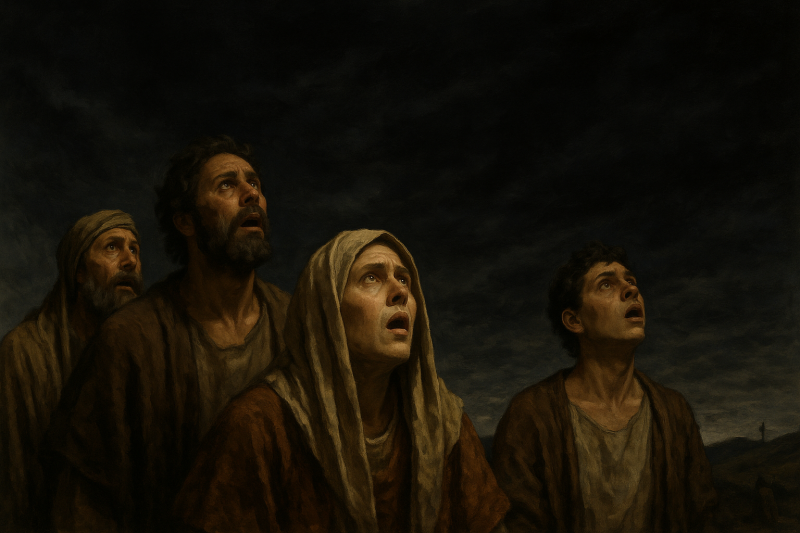The Profound Mystery of Darkness at Calvary
Imagine standing outside on a bright, sunny day, when suddenly, without warning, darkness envelops the land. The sun, just moments ago shining brilliantly, is obscured, leaving you and everyone around you in a state of eerie twilight. This unsettling occurrence isn't just a natural phenomenon; it's a moment that carries deep, spiritual significance. As we delve into the Gospel of Mark, particularly chapter 15, verse 33, we find ourselves confronting such a moment—a supernatural darkness that covered the land during the crucifixion of Jesus. This event, more than just a historical footnote, invites us to explore its profound implications for our faith and our lives today.

The darkness that descended at Calvary was not a simple eclipse. It was Passover, a time when a solar eclipse was impossible due to the lunar cycle. This darkness lasted three hours, from noon until three in the afternoon, a significant period that demands our attention. Why did this happen? What does this darkness symbolize? As we explore these questions, we'll uncover layers of meaning that reveal the depth of Christ's sacrifice and the hope it brings to us.
Concealment: The Hidden Agony of the Cross
The first layer of significance in this darkness is concealment. Jesus hung on the cross for six hours, and while the first three hours were visible to all, the last three were shrouded in darkness. This concealment serves to emphasize the profound, incomprehensible suffering that Jesus endured on our behalf. During these hours, Jesus bore the weight of the world's sins, a burden too terrible for human eyes to witness. This darkness was a divine veil, a mercy that hid the sacred agony of our Savior as He experienced the full wrath of God for our sins.
Consider moments in life when witnessing someone's deep pain feels intrusive, almost sacred. This darkness at Calvary reminds us that some sufferings are too profound to be observed, inviting us to reflect on the mystery of Christ's sacrifice. As Isaiah 52:14 foretold, Jesus' appearance was marred beyond human likeness—a transformation not of physical form, but of the spiritual agony He bore for us.
Curse: The Symbol of Judgment
The darkness also symbolizes a curse, a theme that resonates throughout Scripture. In the Old Testament, darkness often accompanied God's judgment, as seen in the plagues of Egypt (Exodus 10:21-23). This plague of darkness was a precursor to the death of the firstborn, a judgment that led to the liberation of God's people. At Calvary, the darkness signified the curse that Jesus took upon Himself. He became the ultimate Passover Lamb, bearing the curse of sin so that we might be set free.
This darkness should have been a solemn warning to those who crucified Jesus. It echoed the darkness of Egypt, reminding them that they, too, stood under judgment. Yet, in this act of judgment, Jesus provided a way of escape, taking on the curse so that we might receive the blessing of eternal life.
Conquest: Victory in the Midst of Darkness
In the midst of this darkness, there is also a message of conquest. The imagery of darkness suggests defeat, yet it is here that Jesus accomplished His greatest victory. Isaiah 59 speaks of God donning His armor to fight for His people, and at Calvary, Jesus, the light of the world, battled the forces of darkness. It appeared as though darkness reigned, but in truth, Jesus was triumphing over sin and death.
The darkness of Calvary is a powerful reminder that God is at work, even when circumstances seem bleak. Just as Jesus conquered through His death, we too can trust that God is working in the darkest moments of our lives, bringing about His purposes and victories.
Condemnation: A Solemn Warning and a Promise of Hope
Finally, the darkness at Calvary serves as a symbol of condemnation. It is a foretaste of the final judgment, when cosmic signs will herald the return of Christ (Mark 13:24-25). For those who reject Christ, this darkness is a warning of the eternal separation from God that awaits. Yet for believers, it is a reminder of the condemnation that Jesus bore in our place. He endured the darkness so that we might walk in the light.
Reflecting on the darkness at Calvary challenges us to examine our lives. Are there areas where we still walk in darkness, holding onto secret sins? The call is to bring these into the light, to confess and seek God's transforming power. As Paul writes in Ephesians 5:8, "For you were once darkness, but now you are light in the Lord. Live as children of light."
Living in the Light of Calvary
As we conclude our exploration of this profound darkness, let's remember the hope that it brings. Jesus entered the darkness so that we might live in His marvelous light. He has rescued us from the dominion of darkness and brought us into His kingdom (Colossians 1:13). In moments of personal or global darkness, we can hold onto the truth that God is at work, bringing light and life.
Let us give thanks for Jesus, who endured the darkness for our sake. May we live as children of light, reflecting His love and hope to a world in need. As we do, we remember that the darkness has not overcome the light, and it never will.


Add comment
Comments